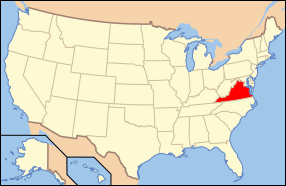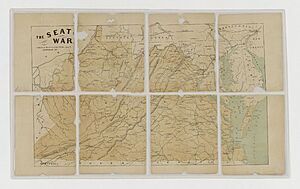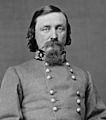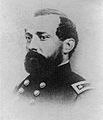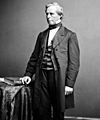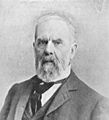Virginia in the American Civil War facts for kids
Quick facts for kids Virginia |
|||||
|---|---|---|---|---|---|
| Nickname(s): "Virginny" | |||||
|
|||||
| Capital | Richmond | ||||
| Largest City | Richmond | ||||
| Admission to confederacy | May 7, 1861 (8th) | ||||
| Population |
|
||||
| Forces supplied |
|
||||
| Governor | John Letcher William Smith Francis Pierpont |
||||
| Senators | William Ballard Preston Allen T. Caperton Robert M. T. Hunter Waitman Willey John Carlile Lemuel Bowden |
||||
| Representatives | List | ||||
| Restored to the Union | January 26, 1870 | ||||
Virginia played a very important role in the American Civil War. It was a Southern state where slavery was allowed. At first, Virginia voted against leaving the Union in April 1861.
However, things changed quickly after the Battle of Fort Sumter. This battle started the war on April 12. When President Abraham Lincoln asked states to send troops to stop the rebellion, Virginia decided to join the Confederacy. This happened on April 17, 1861.
Because of this decision, a new state called West Virginia was formed from 50 counties in western Virginia. These counties wanted to stay with the Union. Also, a "Restored Government of Virginia" was set up in Wheeling. This meant Virginia had two governments during the war.
The Confederate capital moved from Alabama to Richmond, Virginia. This was because Richmond was a very important city to defend. Many major battles of the war happened in Virginia. This was largely because the Confederacy needed to protect its capital. The Union also wanted to capture Richmond.
Contents
Why Virginia Joined the Confederacy
Events Leading to Secession
On October 16, 1859, a man named John Brown led a raid on a federal weapons store in Harpers Ferry, Virginia. U.S. troops, led by Robert E. Lee, stopped the raid. Brown was later executed. This event made tensions about slavery even higher.
In 1860, the Democratic Party split over the issue of slavery. Southern Democrats chose John C. Breckinridge as their candidate for president. When Republican Abraham Lincoln was elected president, many Virginians worried about the future of slavery.
Virginia's Secession Convention
Virginia's governor, John Letcher, called for a special meeting to discuss leaving the Union. This meeting, called the Virginia Secession Convention of 1861, started on February 13, 1861. Most delegates at first wanted to find a compromise and stay in the Union.
However, the situation changed after the Peace Conference of 1861 failed. This conference tried to solve the problems between the North and South. Many Virginians felt that Lincoln's first speech as president was too strong against the South.
During the convention, some leaders from other Southern states spoke. For example, Henry L. Benning from Georgia argued that leaving the Union was the only way to protect slavery. He said that if slavery ended, it would be terrible for white people.
A delegate named Thomas F. Goode also clearly stated the main reason for the convention:
Sir, the great question which is now uprooting this Government to its foundation – the great question which underlies all our deliberations here, is the question of African slavery.
The convention decided that slavery should continue and even expand into new U.S. territories. They also said that states had the right to leave the Union.
Fort Sumter and Lincoln's Call for Troops
The attack on Fort Sumter on April 12, 1861, was a major turning point. Confederate forces fired on the U.S. fort, starting the Civil War. News of this attack made many Virginians strongly support leaving the Union.
On April 15, President Lincoln asked all states still in the Union, including Virginia, to send troops to stop the rebellion. Governor Letcher refused this request. He said that Virginia would not send troops to "invade and coerce" the Southern states.
This refusal led to Virginia's decision to secede. On April 17, the convention voted to leave the Union. This decision was then put to a vote for all citizens.
Virginia Votes to Secede
On May 23, 1861, Virginians voted to officially approve leaving the Union. The vote was 132,201 for secession and 37,451 against. Right after this, Confederate troops moved into northern Virginia.
The day after the vote, the U.S. Army moved into northern Virginia. This set the stage for many battles in the state. Union supporters in Virginia then met to form the Restored Government of Virginia. Francis Pierpont was chosen as its governor. This government supported the Union and raised its own troops.
Virginia's Importance in the War
Virginia had many important resources that both sides wanted to control. Its farms and factories, and the ways to move goods, were key targets.
Most importantly, Virginia was home to Robert E. Lee. He was a U.S. Army Colonel who was offered a Union command. But he turned it down and joined the Confederate army on April 23. Lee became one of the Confederacy's most important leaders.
Richmond: The Confederate Capital
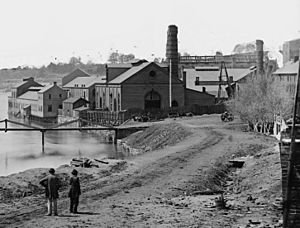
The Confederacy moved its capital to Richmond, Virginia in May 1861. This was a risky move because Richmond was only about 100 miles from the U.S. capital, Washington, D.C.. However, Richmond was chosen because of its important industries.
Richmond was the only large industrial city controlled by the Confederacy for most of the war. Its factories made many war supplies. The Tredegar Iron Works in Richmond was the third largest metal factory in the U.S. It made most of the Confederacy's cannons and other equipment. Richmond also produced guns, bullets, uniforms, and other military goods.
Losing Richmond in April 1865 was a huge blow to the Confederacy. Without Richmond's factories, the South could not make enough supplies to continue fighting.
Other Key Locations
Petersburg, Virginia, was another important city. It was a major railroad hub, connecting the Confederacy to the Deep South. Its defense was vital for Richmond.
The Shenandoah Valley in western Virginia was known as the "Breadbasket of the Confederacy." It provided a lot of food for the Confederate army. The Saltville area in southwest Virginia was also important. It produced salt, which was needed to preserve food for the soldiers.
Major Campaigns and Battles
Virginia saw some of the first and last major battles of the Civil War.
1861: Early Battles
The first big battle happened on July 21, 1861, near Manassas. Union forces tried to take control of a railroad junction there. But the Confederates won the First Battle of Bull Run (also called First Manassas).
1862: Union Retreats
In 1862, Union General George B. McClellan tried to capture Richmond but was forced to retreat by Robert E. Lee's army. Later, Union General Pope was defeated at the Battle of Second Bull Run. The Confederates also won a major victory at the Battle of Fredericksburg.
1863: Chancellorsville
Fighting continued in 1863. Union General Hooker was defeated by Lee's army at the Battle of Chancellorsville.
1864: Grant's Campaigns
In 1864, Union General Ulysses Grant led the Overland Campaign in Virginia. This campaign involved many tough battles, like the Wilderness and Cold Harbor. It ended with the Siege of Petersburg, which eventually led to the Confederate defeat.
During this time, a Richmond newspaper called the Southern Punch wrote about the Confederacy's goals:
[...] WE ARE FIGHTING FOR INDEPENDENCE THAT OUR GREAT AND NECESSARY DOMESTIC INSTITUTION OF SLAVERY SHALL BE PRESERVED, and for the preservation of other institutions of which slavery is the ground work ...
1865: The End of the War
In April 1865, the Confederate government left Richmond as Union forces closed in. The Confederates set fire to some public buildings to prevent them from being used by the Union army. This fire burned about a quarter of the city. However, the Union Army helped put out the fires, saving much of Richmond.
The war officially ended when Robert E. Lee surrendered at Appomattox Court House in Virginia.
Battles in Virginia
- Battle of First Bull Run (July 21, 1861)
- Battle of Hampton Roads (USS Monitor and CSS Virginia)
- Peninsula Campaign
- Seven Days Battles
- Battle of Malvern Hill
- Northern Virginia Campaign
- Battle of Second Bull Run
- Battle of Fredericksburg
- Battle of Chancellorsville
- Bristoe Campaign
- Mine Run Campaign
- Overland Campaign
- Bermuda Hundred Campaign
- Battle of Cold Harbor
- Richmond-Petersburg Campaign
- Battle of the Crater (July 30, 1864)
- Valley Campaigns of 1864
- Appomattox Campaign
- Battle of Brandy Station
- Battle of Ball's Bluff
West Virginia Becomes a State
When Virginia voted to secede, many delegates from the western counties voted against it. These counties had fewer enslaved people and stronger ties to the Union.
After Virginia seceded, the Unionist government in Wheeling was officially recognized by President Lincoln. This government, led by Governor Francis H. Pierpont, worked to create a new state.
On October 24, 1861, the people in these western counties voted to become a separate state. The new state, West Virginia, officially joined the Union on June 20, 1863.
Soldiers from Virginia
Virginia sent about 155,000 soldiers to fight for the Confederacy. Many famous Confederate generals were from Virginia, including Robert E. Lee, Stonewall Jackson, and J.E.B. Stuart.
Around 27,000 Virginians fought for the Union Army. This included about 21,000 white Virginians (many from what became West Virginia) and about 6,000 African Americans. Some important Union leaders were also from Virginia, such as General-in-Chief Winfield Scott and Admiral David Farragut.
After the War
Many battlefields and historic sites in Virginia have been preserved. These include Manassas National Battlefield Park and Richmond National Battlefield Park. These sites help us remember the important events of the Civil War.
In recent years, there have been discussions about removing Civil War monuments in Virginia. Many people believe these statues are symbols of racism and slavery.
Images for kids
Notable Confederate Leaders from Virginia
-
Gen.
Robert E. Lee -
Gen.
Joseph E. Johnston -
Lt. Gen.
Thomas J. Jackson -
Lt. Gen.
A. P. Hill -
Lt. Gen.
Richard S. Ewell -
Lt. Gen.
Jubal A. Early -
Maj. Gen.
J.E.B. Stuart -
Maj. Gen.
George Pickett -
Maj. Gen.
Fitzhugh Lee -
Brig. Gen.
Lewis A. Armistead -
Brig. Gen. (frmr. Gov.)
John B. Floyd -
Col.
John S. Mosby -
Commr. to U.K. & France
James Murray Mason -
Spy
Belle Boyd
Notable Union Leaders from Virginia
-
Lt. Gen.
Winfield Scott -
Maj. Gen.
George Henry Thomas -
Adm.
David Farragut -
Maj. Gen.
Jesse Lee Reno -
Maj. Gen.
John Newton -
Brig. Gen.
John Davidson -
Brig. Gen.
Philip St. George Cooke -
Brig. Gen.
William R. Terrill -
Brig. Gen.
Alexander Brydie Dyer -
Brig. Gen.
William Hays -
1st Black Officer Maj.
Martin Delany -
Army Judge Advocate
Major John F. Lee -
Medal of Honor Sgt.
William Harvey Carney -
U.S. Sen.
Waitman T. Willey -
U.S. Sen.
John S. Carlile -
U.S. Sen.
Lemuel J. Bowden -
U.S. Rep.
Joseph Segar -
U.S. Rep.
Lewis McKenzie -
U.S. Rep.
William G. Brown Sr. -
U.S. Rep.
Jacob B. Blair -
U.S. Rep.
Kellian Whaley -
Abolitionist and Spy
Elizabeth Van Lew -
Spy
Mary Bowser -
Abolitionist
Moncure Daniel Conway
See also
- Army of Northern Virginia
- Confederate States of America States (animated map of secession and confederacy)
- Virginia Units in the Civil War




